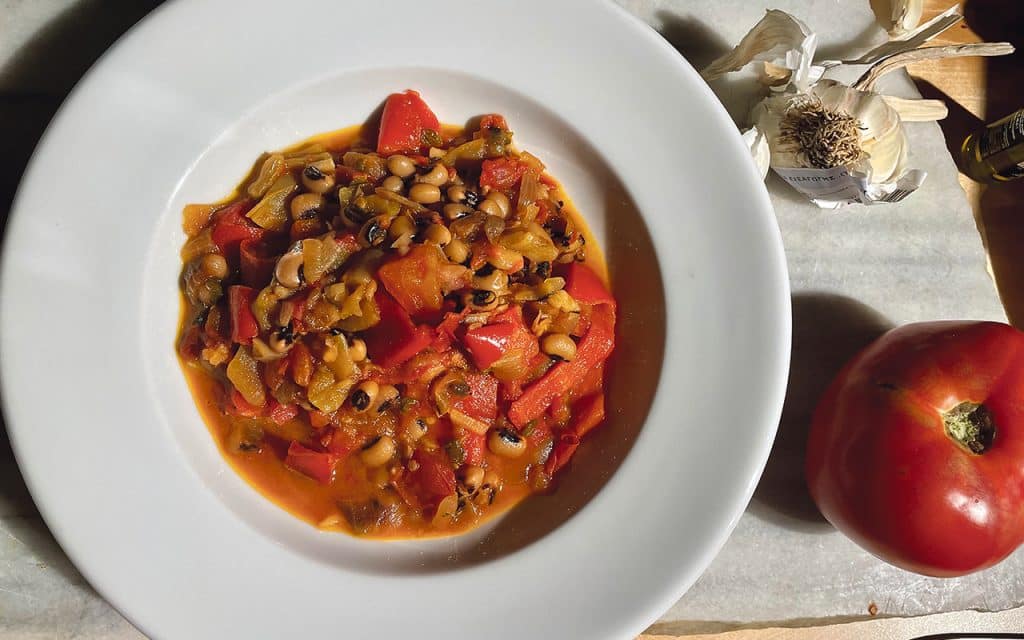
We’re just in the door from a trip to Greece. It wasn’t our usual island hopping, we were on the mainland this time. We started off visiting the Acropolis in Athens and then drove through the plains where the wheat had been harvested leaving a golden stubble in the sunshine, up to Delphi which is a small town in the hills and the only time we put a jumper on.
Delphi is home to the Temple of Apollo and the Navel of the World. The remains are remarkable and one can only wonder at the location which is spectacular, remote and only reached by a road that zig zags up the hills. It makes you think of all the manpower needed to move all the materials up there. These are major sites which have been restored and they are jammed with tourists and guides. There are ancient remains scattered all over Greece so we decided to just wander and explore the minor ruins after these were ticked off the list. Our trip continued back down then along the beautiful coast line with calm blue sea, fluffy clouds surrounding the mountains on the other side of the bay, then up and through lots of tunnels to traverse the rugged mountains. We stopped off for swims in the warm sea and ate at tavernas along the way.
We stayed in a mixture of hotel rooms and apartments in small towns and walked the hills, tripping over relics and sometimes burnt-out olive trees. Although wild fire damage is devastating, I was amazed to see the trees regenerate from the base and grow again. There are olive trees absolutely everywhere, the oranges are beginning to ripen and the pomegranates are dripping from the trees.
We visited one more major site in Epidaurus. We arrived around midday after our ‘early’ start, which was the same time as the tour buses, took one look at the crowds and ran away. We spent the afternoon clambering along the coast and down to a small beach where it began to rain. Horror of horrors! After a wet swim we decided to give Epidaurus another call and this time it was perfect, the rain had made everyone scuttle for shelter and go home.
Epidaurus dates back to 4BC and is the biggest and best-preserved amphitheatre in Greece with 34 tiers of seats, which can accommodate 12,000 spectators. It is known for its perfect acoustics and, as we had the place more or less to ourselves, we put Con in the middle of the auditorium to sing – much to the bemusement of the other three tourists – and clambered to the top to check it out, and sure enough, clear as a bell!
We then wandered down to an area known as the Mani, which is sparsely populated and wild. There are lots of small villages up the hills with towers at the top and of course olives, pomegranates and cactus fruit.
The weather was quite ‘Irish’, in as much as it kept changing. One minute blue sky, then fluffy clouds and sometimes ominous black clouds that opened up and chucked down rain but the temperature was Greek.
On the food front it was all Greek. Plenty of Greek salads, sardines and souvlaki. There are also beans which are present in all blue zones – places where people often live to become one hundred. Cheap, plentiful and nutritious and something that I really enjoy. We always mix and match cooking for ourselves and eating out when we’re travelling and one day when it was bucketing with rain I decided a nice pot of beans was just what we needed. I grabbed an umbrella and went to the mini market to buy a can of beans and some vegetables only to discover they don’t have canned beans. I was so surprised that a country that eats so many beans doesn’t use canned beans. There was a great variety of dried beans and lentils but most of them need forward thinking and soaking. I bought some blackeye beans, which can be cooked from scratch, red and green peppers, tomatoes and an onion. There are plenty of fresh herbs growing everywhere and our little house had a lush oregano patch so that decided the dinner.
This what I made, it’s more Greek-inspired than a Greek recipe but the addition of orange peel in the beans is something that I have come across many times and an interesting and tasty addition.
Blackeye beans with peppers, tomato and orange
Serves 3-4
• 150g blackeye beans
– or 1 can
• Pared zest of 1 small orange
• 1 onion
• 75mls olive oil
• 2 skinny red peppers or one regular
• 2 skinny green peppers
or 1 regular
• 2 cloves garlic, peeled and chopped
• 2 big ripe tomatoes, chopped or 1 can
• Small glass white wine (opt)
• A handful of fresh oregano
or 1tsp dried oregano
• salt
Put the blackeye beans into a pot and cover generously with water. Pare a few strips of peel from the orange and add to the pot. Bring to the boil then turn to simmer for roughly one hour or until the beans are tender.
Peel and roughly chop the onion. Heat a pan and add enough olive oil to generously cover the bottom then add the onion. When it begins to sizzle turn the heat to medium. Keep an eye on the temperature as you don’t want the onions to brown, just to melt down.
Remove the seeds from the peppers then cut into medium/small sized strips. Add to the pan with the onion and continue cooking .Season with a little salt. When the peppers are tender stir in the chopped garlic and oregano. Cook for couple of minutes then stir in the chopped tomatoes and white wine. Increase the heat, allow everything to bubble up then reduce the heat to a gentle simmer until it reduces and becomes jammy.
Hopefully by this time your beans are cooked. Lift the beans from the cooking water onto the vegetables and season with salt and pepper. Add some bean cooking liquid to thin the mix if it is too thick.
Serve with fresh bread or chippy potatoes on the side.
Happy October!
Karen
Lettercollum Kitchen Project,
Timoleague
info@lettercollum.ie
www.lettercollum.ie
0238846251



